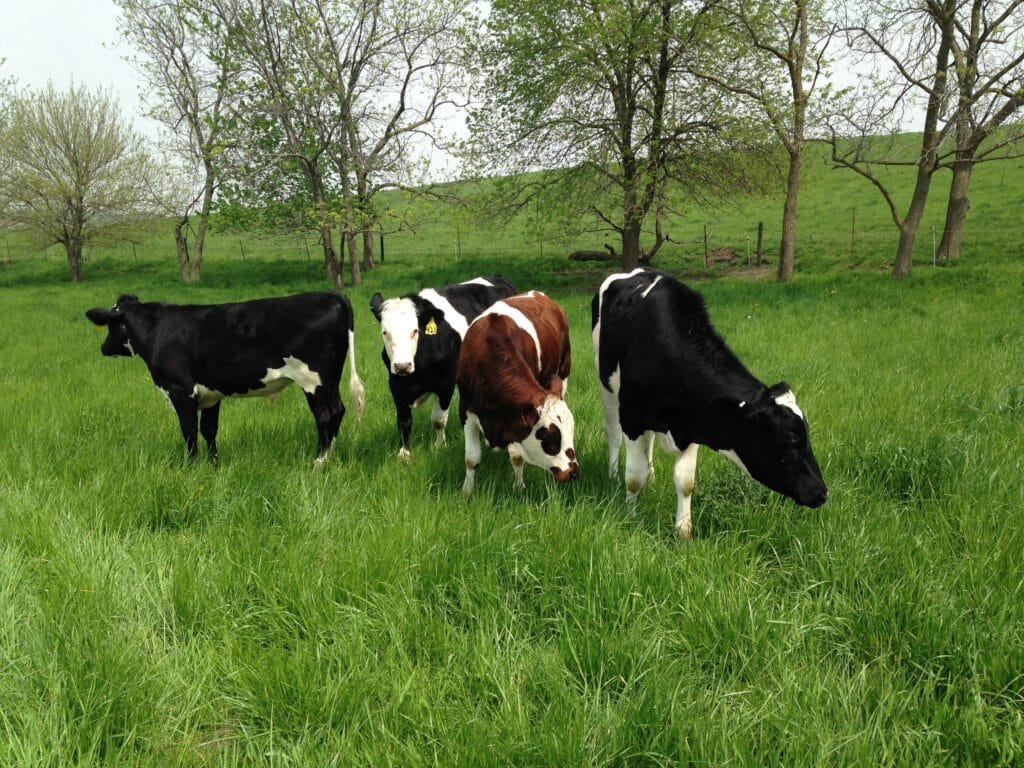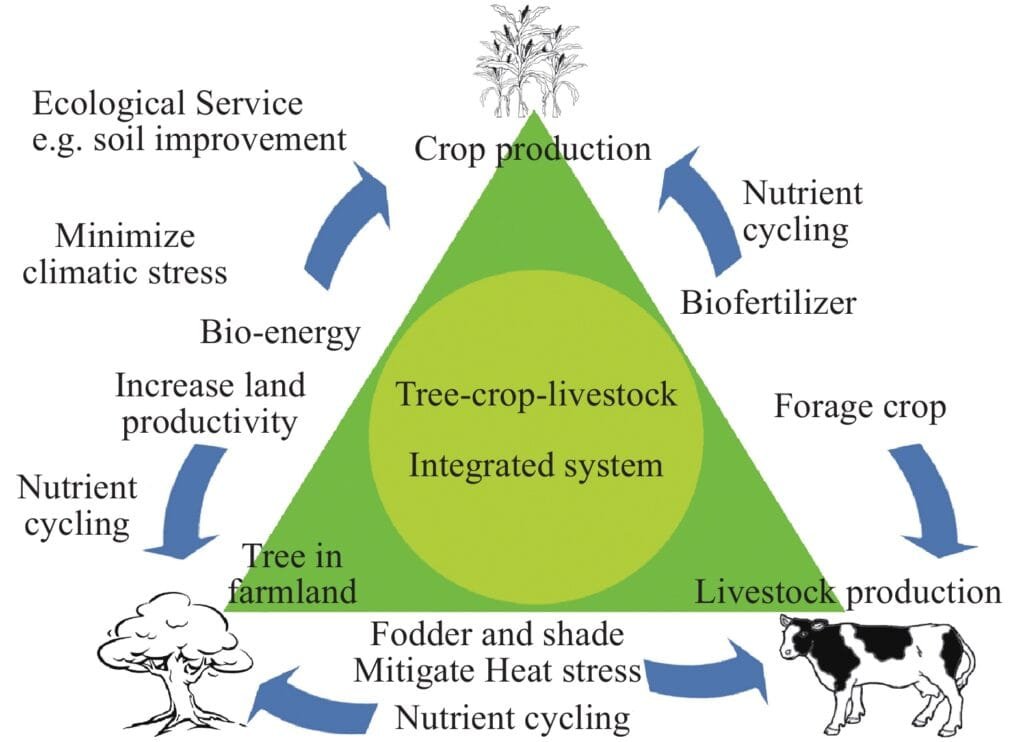
Summary of Contents
Introduction
Have you ever wondered if your farm could do more with fewer resources? Livestock integration might be the answer. By combining animal husbandry with crop production, you create a system where each part supports the other, leading to better farm sustainability. On my farm in Northeast India, livestock integration has allowed me to improve soil fertility, manage waste more efficiently, and get the most out of both my animals and crops.
In this article, I’ll explain what livestock integration is, how it works, and why it’s a game-changer for sustainable farming. Let’s dive into how animals and crops can work together to create a thriving, balanced farm ecosystem.
What is Livestock Integration?
Livestock integration is the practice of combining animal husbandry with crop farming in a way that each supports the other. In an integrated system, animals provide manure that enriches the soil, while crops provide feed for the animals. This cycle reduces the need for external inputs like chemical fertilizers or industrial feed and helps farmers make the most of their land and resources.
It’s like having a closed-loop system on your farm—everything you need is generated from within, reducing costs and improving sustainability. Livestock integration not only boosts farm productivity but also enhances soil health, biodiversity, and resilience.
Step 1: Choose the Right Livestock for Your Farm
To get started with livestock integration, the first step is choosing animals that suit your farm’s needs. On my farm, I raise cows and chickens, which provide manure for the soil while also giving milk, eggs, and meat. You could also consider sheep, goats, or pigs depending on your farm’s size and the crops you grow.
The key is to pick animals that provide multiple benefits—manure for the soil, food for the family, and possibly an extra source of income from milk, eggs, or meat.
Step 2: Develop a System for Crop-Livestock Interaction
Once you’ve chosen your livestock, plan how they will interact with your crops. You can use livestock to graze on crop residues after harvest, and their manure will enrich the soil. In return, the crops will produce straw or fodder that can feed the animals. On my farm, I often let the cows graze on leftover paddy straw, which provides a cheap feed option while recycling nutrients back into the soil.
By rotating animals around your farm and using crop residues for feed, you create a natural, self-sustaining cycle that benefits both livestock and crops.
Step 3: Manage Waste Efficiently
A big part of livestock integration is managing animal waste properly. Livestock manure is a fantastic organic fertilizer, rich in nutrients that improve soil health. Instead of relying on chemical fertilizers, I use cow dung and chicken manure on my fields, which keeps my soil fertile without harmful chemicals.
In regions like Northeast India, where the cost of fertilizers can be high, using livestock waste not only saves money but also helps maintain a healthy, sustainable farm ecosystem.
Benefits of Livestock Integration

1. Improves Soil Fertility
Livestock manure is rich in essential nutrients like nitrogen and phosphorus, which help improve soil structure and fertility. Using manure as a natural fertilizer reduces the need for synthetic inputs, making your farm more sustainable and cost-effective.
2. Efficient Resource Use
Livestock can graze on crop residues, converting what would otherwise be waste into valuable feed. This not only reduces feed costs but also makes better use of the farm’s resources. On my farm, cows graze on leftover crops like paddy straw, which helps minimize waste.
3. Diversifies Income
Livestock integration allows farmers to diversify their income. In addition to selling crops, you can sell milk, eggs, or meat from your livestock. This diversified income stream can make your farm more resilient to market fluctuations.
4. Enhances Biodiversity
A farm with both animals and crops is often more biodiverse than one that focuses on just one type of production. Livestock integration introduces natural cycles that benefit the entire ecosystem, from beneficial insects to improved soil microbes.
5. Reduces Dependence on External Inputs
By producing both food and fertilizer within your farm, you reduce reliance on external inputs like commercial feed and chemical fertilizers. This reduces costs and makes your farm more self-sufficient.
Challenges of Livestock Integration
While livestock integration has many benefits, it also comes with challenges:
- Management Complexity: Managing both livestock and crops requires more planning and attention. You’ll need to balance the needs of your animals with your crops, ensuring both get the resources they need.
- Labor-Intensive: Livestock integration can be more labor-intensive than standard farming practices. Animals require daily care, and integrating them with crop production adds to the workload.
Best Practices for Livestock Integration
1. Rotate Livestock Grazing: Allow animals to graze on different parts of the farm in rotation. This helps prevent overgrazing, reduces soil compaction, and evenly distributes manure.
2. Compost Manure: Instead of directly applying raw manure to crops, consider composting it first. Composting helps break down harmful pathogens and makes the nutrients more readily available to plants.
3. Grow Fodder Crops: Consider growing specific crops like alfalfa or clover as fodder for your animals. These crops can enrich the soil and provide high-quality feed for livestock.
Economic Insights: How Livestock Integration Boosts Profitability
Livestock integration is not just about sustainability—it also makes good financial sense. By producing your own organic fertilizers and livestock feed, you significantly cut costs on external inputs like synthetic fertilizers and commercial feeds. Additionally, livestock products like milk, eggs, and meat provide additional income streams, making your farm more financially resilient.
In India, especially in regions like Northeast India, where smallholder farmers operate on limited land, livestock integration is a practical way to boost farm productivity while reducing dependency on costly external resources.
Conclusion: Livestock Integration for a Sustainable Farm Future
Livestock integration is one of the best ways to create a sustainable, resilient farming system. By combining crop production with animal husbandry, you build a farm where each part supports the other. The result is improved soil health, reduced waste, diversified income, and greater resource efficiency. For small farmers in Northeast India, where resources can be limited, livestock integration is a smart, long-term solution to increase productivity while maintaining farm sustainability.
If you haven’t tried livestock integration yet, now’s the time to get started! With the right animals and a well-planned system, your farm can thrive in ways you never thought possible.
FAQ Section
What is the integration of livestock?
Livestock integration is the practice of combining livestock rearing with crop farming, where the two systems support each other. Animals provide manure to enrich the soil, while crops offer feed for the livestock, creating a sustainable farm cycle.
What is crop-livestock integration in India?
In India, crop-livestock integration is commonly practiced by smallholder farmers who combine animal husbandry with crop farming. Livestock like cows, goats, and poultry are raised alongside crops such as wheat, rice, and vegetables, allowing both systems to benefit each other.
Why is livestock important in the integrated farming system?
Livestock is crucial in integrated farming systems because animals provide manure, which improves soil fertility, and they can graze on crop residues, reducing waste. This system also diversifies farm income by producing milk, eggs, and meat.
What are the principles of integrated livestock farming?
The key principles of integrated livestock farming include efficient resource use (e.g., using animal manure as fertilizer), improving soil health, reducing external inputs, and enhancing biodiversity. The aim is to create a closed-loop system where each part supports the whole.
What is an example of an integrated crop-livestock system?
An example is a farm where cows graze on leftover paddy straw after the rice harvest, and the manure from the cows is then used to fertilize the fields for the next crop cycle. This creates a self-sustaining system that reduces waste and improves productivity.
